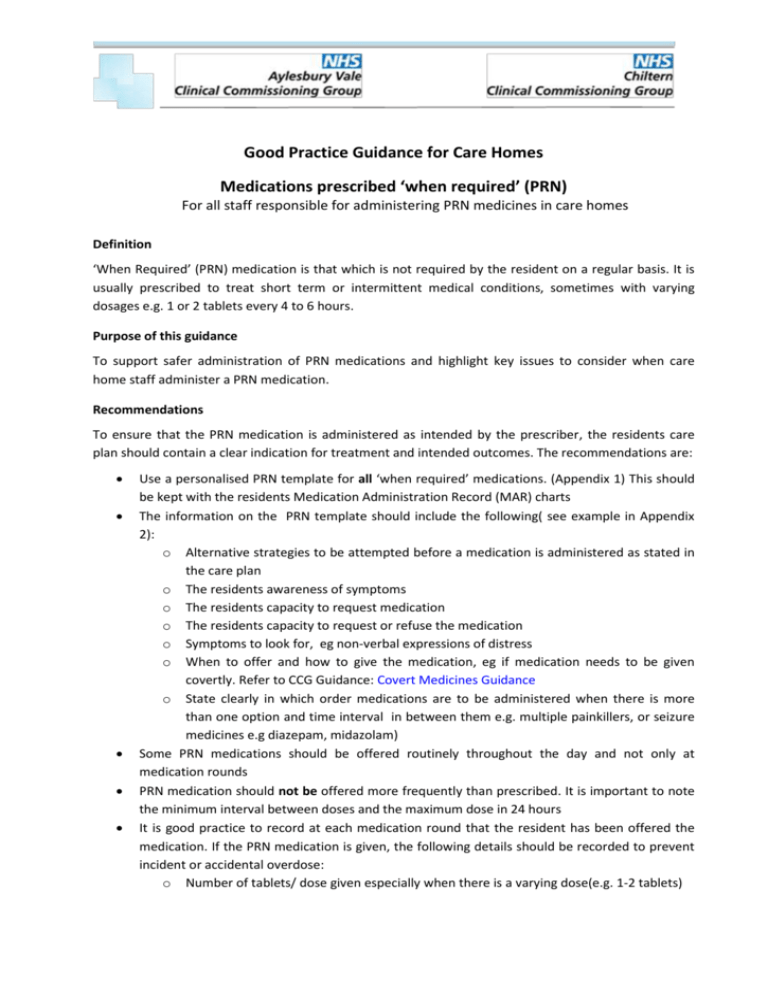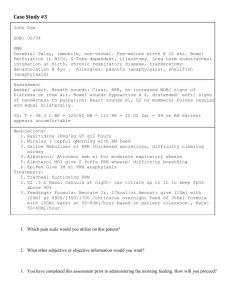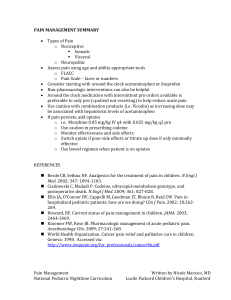Good Practice Guidance For Care Home Prn Medications
advertisement

Good Practice Guidance for Care Homes Medications prescribed ‘when required’ (PRN) For all staff responsible for administering PRN medicines in care homes Definition ‘When Required’ (PRN) medication is that which is not required by the resident on a regular basis. It is usually prescribed to treat short term or intermittent medical conditions, sometimes with varying dosages e.g. 1 or 2 tablets every 4 to 6 hours. Purpose of this guidance To support safer administration of PRN medications and highlight key issues to consider when care home staff administer a PRN medication. Recommendations To ensure that the PRN medication is administered as intended by the prescriber, the residents care plan should contain a clear indication for treatment and intended outcomes. The recommendations are: Use a personalised PRN template for all ‘when required’ medications. (Appendix 1) This should be kept with the residents Medication Administration Record (MAR) charts The information on the PRN template should include the following( see example in Appendix 2): o Alternative strategies to be attempted before a medication is administered as stated in the care plan o The residents awareness of symptoms o The residents capacity to request medication o The residents capacity to request or refuse the medication o Symptoms to look for, eg non-verbal expressions of distress o When to offer and how to give the medication, eg if medication needs to be given covertly. Refer to CCG Guidance: Covert Medicines Guidance o State clearly in which order medications are to be administered when there is more than one option and time interval in between them e.g. multiple painkillers, or seizure medicines e.g diazepam, midazolam) Some PRN medications should be offered routinely throughout the day and not only at medication rounds PRN medication should not be offered more frequently than prescribed. It is important to note the minimum interval between doses and the maximum dose in 24 hours It is good practice to record at each medication round that the resident has been offered the medication. If the PRN medication is given, the following details should be recorded to prevent incident or accidental overdose: o Number of tablets/ dose given especially when there is a varying dose(e.g. 1-2 tablets) o The exact time of administration to make sure the required time interval has passed before administering the next dose Monitor the resident and record the residents response to the medicine. Contact the GP for advice or review if the resident(s): o Appears to be experiencing side effects o Appears not to benefit from the medication o Requests it more frequently than usual o Requests the PRN medication more frequently than prescribed o Medical condition has deteriorated o Rarely request or regularly declines the PRN medication PRN medicines should be stored securely and accessible on request. They should be kept in original packaging with pharmacy label on the medicine Keep appropriate stock levels to meet the residents changing needs If PRN medication is left over at the end of the monthly cycle and it is still in date then this should be ‘Carried forward’ from one month to the next.. This will avoid unnecessary medicines waste. Refer to CCG Guidance: Reducing Medicines Waste in Care Homes The quantity of PRN medicines ‘carried forward’ should be recorded on the new MAR chart so there is an accurate record of the stock level which will help when undertaking audits The PRN medication should be reviewed routinely and the review date clearly stated Other Useful Resources The listed CCG Care Homes Guidance can all be assessed on http://www.buckscc.gov.uk/socialcare/care-for-adults/provider-information/quality-in-care/policies-and-guidelines/ Homely remedies Reducing Medicines Waste Medicines Policy Standards References 1. NICE Managing medicines in care homes SC1: 2014 accesses at www.nice.org.uk 2. CQC Pharmacy Tip: Medication prescribed to be taken when required( October 20008) which has been withdrawn 3. Oxfordshire Clinical Commissioning Group Good Practice Guidance F: Medication prescribed to be taken ‘when required’ in care homes 4. Northern, Eastern and Western Devon / South Devon and Torbay Clinical commissioning Group When Required Medication(PRN) Guidance Sheet 17 5. British National Formulary April 2015 Date: Unoma Okoli, Care Homes Pharmacist and Seema Gadhia Prescribing Support Pharmacist, Chiltern and Aylesbury Vale CCG May 2015 Ratified by: Medicines Management Joint Executive Team - 21 May 2015 Review date: May 2018 Produced by: Good Practice Guide for Care Homes 2 Medications Prescribed ‘when required’ (PRN) Appendix 1: ‘WHEN REQUIRED’ PRN TEMPLATE The following information must be referred to when offering and administering PRN medication prescribed. This document must be kept at the back of the residents MAR charts for reference. Response to therapy should be recorded in the resident’s clinical note or care plan. Residents name Date of Birth Name of medication and start date Form: tablets/syrup/…………………….* Strength: Route: oral/topical/……………………...* Dose and frequency Minimum time interval between doses Maximum dose in 24hours Prescribed/homely remedy/others………........* Reasons for administration: when the medication should be given- describe in as much detail as possible the condition being treated i.e. signs and symptoms, behaviours, type of pain- where and when, expected outcome. For creams indicate where it should be applied. Any special instructions e.g. before or after food on Predictable side effect : use current BNF or product empty stomach information leaflet to list these Any additional comment/ information Prepared by: Name and signature Designation: Approved by: Name and signature Designation: Date: *Circle as appropriate Review date: Good Practice Guide for Care Homes 3 Medications Prescribed ‘when required’ (PRN) Appendix 2: Example of a completed template ‘WHEN REQUIRED’ PRN TEMPLATE The following information must be referred to when offering and administering PRN medication prescribed. This document must be kept at the back of the residents MAR charts for reference. Response to therapy should be recorded in the resident’s clinical note or care plan. Residents name Date of Birth Mrs Nellie Snow 12/1/1936 Name of medication and start date Form: tablets/syrup/…………………….* Lorazepam Tablet Strength: Route: oral/topical/……………………...* 1mg Oral Dose and frequency Minimum time interval between doses 1 mg tablet to be taken when required 8 hours Maximum dose in 24hours Prescribed/homely remedy/others………........* 2mg Prescribed Reasons for administration: when the medication should be given- describe in as much detail as possible the condition being treated i.e. signs and symptoms, behaviours, type of pain- where and when, expected outcome. For creams indicate where it should be applied. Lorazepam may be used when Mrs Snow becomes anxious. This usually occurs after a visit by her family; she may ask for her children and become restless and agitated. She may appear frightened, she may withdraw to the corner of the room or walk around. Before administration of Lorazepam : Encourage Mrs Snow to go to a quieter area or to sit with you. Encourage her to verbalise her feelings, acknowledge how important her family are to her. Listen to her. Reassure and orientate her. Use distraction methods, e.g. offer a drink, look at photos or go for a walk with her. Only give Lorazepam if these measures don’t work. Lorazepam takes 15 minutes to have an effect. Supervision may be required after administration of Lorazepam , as there may be an increase in levels of confusion, there is an increased risk of falls. Any special instructions e.g. before or after food on Predictable side effect : use current BNF or product empty stomach information leaflet to list these Grapefruit juice and drinks containing caffeine Drowsiness and lightheadedness the next day; should be avoided as they can affect the way confusion (especially in the elderly); amnesia; that Lorazepam tablets work. dependence, muscle weakness Lorazepam may increase risk of dependence; avoid prolonged use (and abrupt withdrawal thereafter) Any additional comment/ information Monitor and record Mrs Snow’s response to Lorazepam and contact her GP for advice or review if she appears to be experiencing side effects( see list above) or requests it more frequently than prescribed or rarely request or regularly declines the PRN medication Prepared by: Name and signature Designation: Mickey Mouse Senior carer Approved by: Name and signature Designation: Minnie Mouse Team leader unit 1 st Date: 1 May 2015 Review date: 1st June 2015 *Circle as appropriate Good Practice Guide for Care Homes 4 Medications Prescribed ‘when required’ (PRN)



